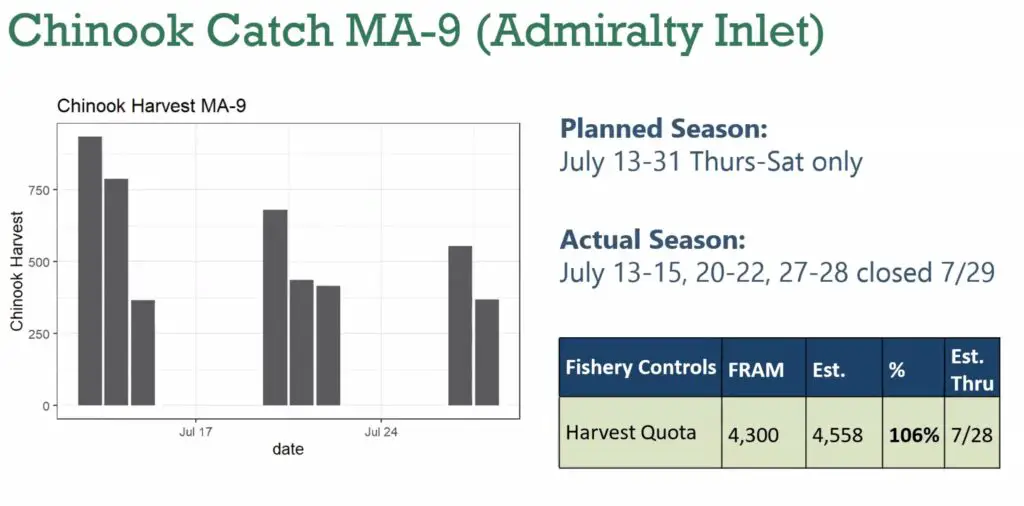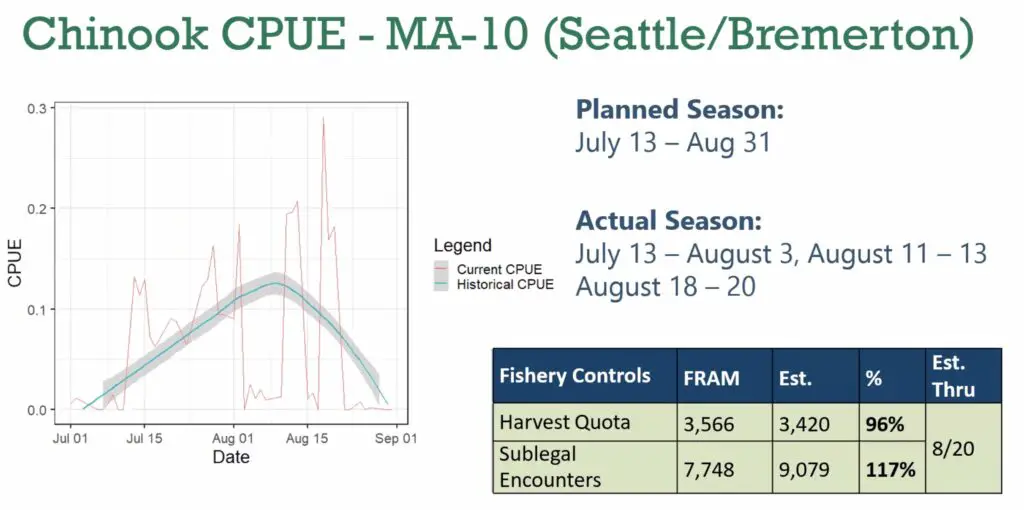
I recently attended the Puget Sound Salmon Town Hall earlier this week where we reviewed the 2023 Puget Sound Salmon Seasons, examined the weather and environmental conditions, introduced the 2024 North of Falcon schedule and WDFW attempted to answer questions from a frustrated public.
In this blog post I highlight the parts I think you should be aware of.
I’ve captured a number of slides from the WDFW presentation which I’ve included below and I will provide my own commentary on along with the WDFW summary where necessary.
Reviewing the 2023 Puget Sound Salmon Seasons
We will focus primarily on Chinook Salmon since that’s where most of the controversy and interest lies.
The below slides all show the Chinook harvest by numbers or CPUE (Catch per Unit of Effort)

While the MA-7 season is far shorter than in years past, it did exceed the original planned season and almost all of the harvest quota was reached.
Only 6 days were spent on the water…

Marine Area 9 almost went the distance in calendar time, though the harvest quota was reached with 8 days total on the water.
Unfortunately, I only got up there for one trip, but it was an incredible experience, especially that bite on the west end of Possession Bar.

In reviewing Marine Area 10, it’s hard to not feel like things could have been handled much differently.
However, with that being said, the harvest quota was basically reached, though it took us several emergency openers throughout August to get there.
There are several ideas floating around of opening MA10 later in July to ensure that a season can continue into August without interruption as long as we are being held to the current sublegal quota system.

Data suggests both above and talking to anyone who really knows the fishery that most of the adult fish show up in that first week of August.
There are not that many fish around in the middle of July when it first opens which can lead to many folks churning through sublegal quotas before the main push of adult fish show up.
I’ve explained the closure and re-opening of Marine Area 10 thoroughly here.

Now we get to the real frustration of the entire 2023 Puget Sound Salmon Season: Marine Area 11.
Marine Area 11 near Tacoma / Vashon has two distinct seasons that could have been continuous if the June season stayed open.
For those that know, June is one of the best chances in Puget Sound to land a nice chinook as there’s salmon from all over chasing bait into the South Sound.
That means actively feeding chinook which makes the ease of hooking salmon more like how it is in the Strait or ocean compared to the migration of spawning fish which show up in big numbers in August and are often more difficult to get to bite.
I got out one day and had decent success, but the season closed soon after due to too many encounters with unmarked salmon.
Now for the real painful part of the summer salmon season: The July opener of Marine Area 11. We only hooked 24% of the harvest quota due to too many encounters with unmarked salmon and with too many sublegals.
Many folks joined the call to express their frustration that they had never seen anything like this in their 50 years of fishing the South Sound. I could almost hear the San Juan Islands angler saying “Hold my beer” though.
Whatever we do in the North of Falcon Process in 2024, we must avoid this outcome. Myself and many others are doing whatever we can to ensure this doesn’t happen again.
What does 2023 Puget Sound Salmon have to do with 2024? I’m glad you asked! Let’s look ahead now in this next section.
What to Expect in 2024 for Puget Sound Salmon Season Outlook

The bottom line is we don’t know the forecasts yet and we don’t have all the other inputs from Northern fisheries (Alaska and Canada) which have a dramatic impact on our allowable quotas.
We do however don’t expect a big upside surprise that dramatically changes things. We also don’t have reason to be pessimistic about the return in 2024 such that we are bracing for any particularly bad news either.

If you go into 2024 expecting a likely repeat of 2023’s seasons and quotas you will probably be in the ballpark of where things will land.
But let’s review some of the other factors as well.
2024 Ocean Conditions, Weather, and Environmental Factors
One of the inputs into how we think about the 2024 return and future run health is the ocean conditions, weather pattern and environmental factors.

I’m pleasantly surprised that this current El Niño could be short-lived and could actually go neutral or back to La Niña by August of 2024.
La Niña is far better for salmon run health and I’ve been concerned that our current challenges with dry summers and heavy rains when combined with the potential for ocean blobs and/or low snowpack could really hurt our already struggling ESA-listed natural origin Chinook to the point that fishing seasons would be massively impacted.

The stoplight chart from NOAA is slightly above average and should be taken as an overall positive for 2024 and beyond.

Good news on this front! I feared many more negative surprises to emerge in this area.
Additional Thoughts about the WDFW Presentation

This is one of my favorite slides because it helps explain the different groups involved with salmon fishery management and what geographical areas they cover.

There were a series of slides and graphs, including the ones below this one which WDFW appeared to use as a way to counter some popular negative narratives about salmon management in the public arena.
Basically, when there’s more fish, we have more catch and opportunity.
I get what they are trying to communicate, but I’m not sure it resonated.

Here’s another graph from a different presentation that we look at as part of the Puget Sound Recreational Fishing Enhancement Fund.
The number of trips is down, and fishing days open are down.
The slide above does not match any kind of public perception of what’s going on. It does seem that both when salmon runs are below abundance that opportunity is taken away AND when salmon runs are abundant they are also curtailed.
I stopped trying to take my out-of-town friends to Sekiu and plan trips months in advance as we’ve seen an abundance of salmon close seasons just as quickly as a lack of abundance.


Reviewing the above graphs paints a picture of where effort and catch are shifting. Marine Areas 7 and 8 have dropped off dramatically due to constraining stocks.
We’ve also seen a catch increase in places like Marine Areas 12 and 13 where these constraining stock issues don’t exist to nearly the same extent.

I continue to see this topic brought up around catch per day being much higher in the last few years.
I’ve seen social media blamed and that the recreational fleet is just better at catching salmon these days.
I would like to think this correlates to when I started this blog and associated YouTube channel, but I’m just being silly!
I do suspect this catch per day increase will correlate with the reduction of salmon fishing days open.
When the same number of anglers are presented with far fewer days available to fish, effort is not spaced out and everyone crams into the early part of a season for fear it will close without getting to participate.
I sincerely hope this won’t factor into season crafting as we need to understand this more thoroughly before shaping seasons based on these assumptions of greater angler efficiency.
This becomes a self-fulfilling prophecy and a cycle of shorter seasons results in greater angler participation and effectiveness. Particularly when we try to align the open season to the most prolific presence of adult harvestable hatchery fish.
Wrapping up
Stay tuned for more coverage of the whole salmon season setting process here on the blog, but also likely on YouTube.
I want to hold some live Q&A sessions where I can attempt to answer questions about how this process works and what’s going on with all of it to the best of my abilities.
Also, we still have our blackmouth opportunity coming up on March 1st, head over to my page on Puget Sound Blackmouth Fishing.
Also, check out my page on How to Fish for Puget Sound Salmon.
Terrific report, Kyle. You put a lot of work into these these extremely informative reports. Really appreciate it. Keep it up!
Thanks Bryan! With encouraging comments like this, I can’t help but keep putting out helpful content!